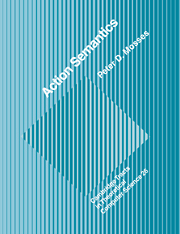Book contents
Chapter 1 - Language Descriptions
Published online by Cambridge University Press: 19 January 2010
Summary
Descriptions of programming languages have several important applications.
Different applications require different features of descriptions.
Informal descriptions are inadequate: formality is essential.
Good pragmatic features are needed to make formal descriptions usefu.
Comprehensive language descriptions involve both syntax and semantics.
Standards relate syntax and semantics to implementations.
This chapter provides some background for the main topic of this book, namely the action semantic description of programming languages. We start by identifying some important uses for descriptions of programming languages. Although various uses require different features of descriptions, these requirements are not necessarily conflicting. Formality is a particularly important feature. We go on to consider the factorization of language descriptions into syntax and semantics, and discuss how they relate to the pragmatic issue of setting standards for programming languages.
Motivation
Programming languages are artificial languages. Programs written in them are used to control the execution of computers. There are many programming languages in existence. Some are simple, intended for special purposes; others are complex and general-purpose, for use in a wide variety of applications.
Even though programming languages lack many of the features of natural languages, such as vagueness, it is not at all easy to give accurate, comprehensive descriptions of them. Which applications require descriptions of programming languages—and hence motivate the study of appropriate frameworks for such descriptions?
First, there is the programming language design process.
- Type
- Chapter
- Information
- Action Semantics , pp. 3 - 20Publisher: Cambridge University PressPrint publication year: 1992

